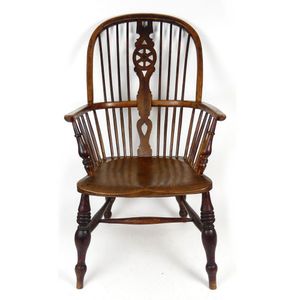English Windsor Elbow Chair with Stick Back and Turned Legs
You must be a subscriber, and be logged in to view price and dealer details.
Subscribe Now to view actual auction price for this item
When you subscribe, you have the option of setting the currency in which to display prices to $Au, $US, $NZ or Stg.
- Turning - Any part of a piece of furniture that has been turned and shaped with chisels on a lathe. Turned sections include legs, columns, feet, finials, pedestals, stretchers, spindles etc. There have been many varieties and fashions over the centuries: baluster, melon, barley-sugar, bobbin, cotton-reel, rope-twist, and so on. Split turning implies a turned section that has been cut in half lengthwise and applied to a cabinet front as a false decorative support.
- Turned Legs - are legs which have been turned on a lathe. In use from the 16th century, turned legs on tables, chairs and cabinets became more frequent until, by the 1830s, the Georgian square or tapered leg was rarely found except in country pieces.
- Splat - The central back support between the top rail and the seat in chairs and couches. They may take a variety of forms, and run either horizontally or vertically.
- Elbow Chair - Another name given to a dining chair with arms, more commonly called a carver chair.
- Birch - Birch is a Northern Hemisphere hardwood, closely related to the beech/oak family, and was a timber popular with 18th century craftsmen. Because of the blonde-golden colour of the grain when polished and its close grain, as a veneer it is often used as a substitute for satinwood where cost savings are required. From the late 18th century cabinetmakers in Russia and Eastern Europe used it in the solid for chairs and other furniture.
Karelian birch is birch with a burr grain that resembles marble, from the Karelia region between Finland and Russia. Because only 30% to 40% of seeds result in trees with Karelian birch features, and the fact that it is very slow growing, the timber is very expensive.
This item has been included into following indexes:
-
chairs, singles / pairs / threes, style or period
- elbow 198
- elm 239
- Victorian, other styles 1,220
- Windsor 166
Visually similar items

A child's elm wood Windsor chair.

An ash and elm Windsor armchair, English, 1st half of the19th century, 100 cm high, 57 cm wide, 57 cm deep

A George III country elm and beech Windsor armchair, the hoop back with central pierced splat flanked by plain spindles, turned arm supports, legs and base stretchers, shaped elm seat.

An old oak and beech high back Windsor elbow chair, with turned front legs and stretcher base.
